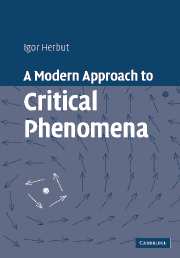
-
Select format
-
- Publisher:
- Cambridge University Press
- Publication date:
- 06 July 2010
- 04 January 2007
- ISBN:
- 9780511755521
- 9780521854528
- 9780521142380
- Dimensions:
- (247 x 174 mm)
- Weight & Pages:
- 0.605kg, 220 Pages
- Dimensions:
- (244 x 170 mm)
- Weight & Pages:
- 0.36kg, 224 Pages
You may already have access via personal or institutional login
Book description
Critical phenomena is one of the most exciting areas of modern physics. This 2007 book provides a thorough but economic introduction into the principles and techniques of the theory of critical phenomena and the renormalization group, from the perspective of modern condensed matter physics. Assuming basic knowledge of quantum and statistical mechanics, the book discusses phase transitions in magnets, superfluids, superconductors, and gauge field theories. Particular attention is given to topics such as gauge field fluctuations in superconductors, the Kosterlitz-Thouless transition, duality transformations, and quantum phase transitions - all of which are at the forefront of physics research. This book contains numerous problems of varying degrees of difficulty, with solutions. These problems provide readers with a wealth of material to test their understanding of the subject. It is ideal for graduate students and more experienced researchers in the fields of condensed matter physics, statistical physics, and many-body physics.
Reviews
Review of the hardback:'This relatively short and extremely well written book is what i would recommend to every graduate student in condensed matter physics as compulsory reading. …I am sure the students will appreciate its manageable size and conciseness, its crisp argumentation as well as its elegant and not overwhelming mathematical proofs.'
Source: Journal of Statistical Physics
Contents
Metrics
Full text views
Full text views help Loading metrics...
Loading metrics...
* Views captured on Cambridge Core between #date#. This data will be updated every 24 hours.
Usage data cannot currently be displayed.
Accessibility standard: Unknown
Why this information is here
This section outlines the accessibility features of this content - including support for screen readers, full keyboard navigation and high-contrast display options. This may not be relevant for you.
Accessibility Information
Accessibility compliance for the PDF of this book is currently unknown and may be updated in the future.


